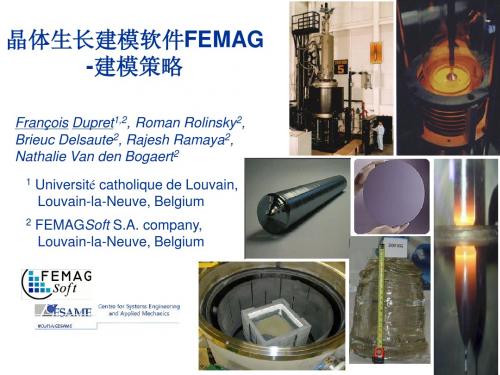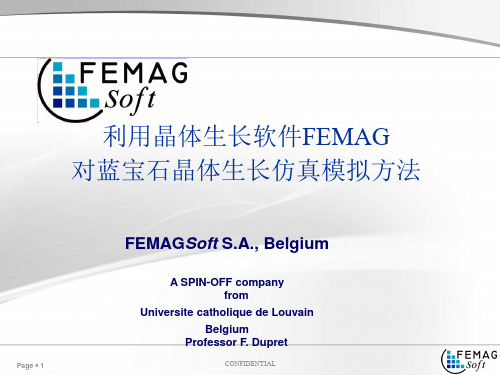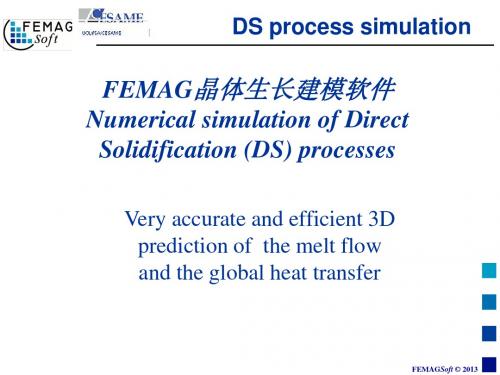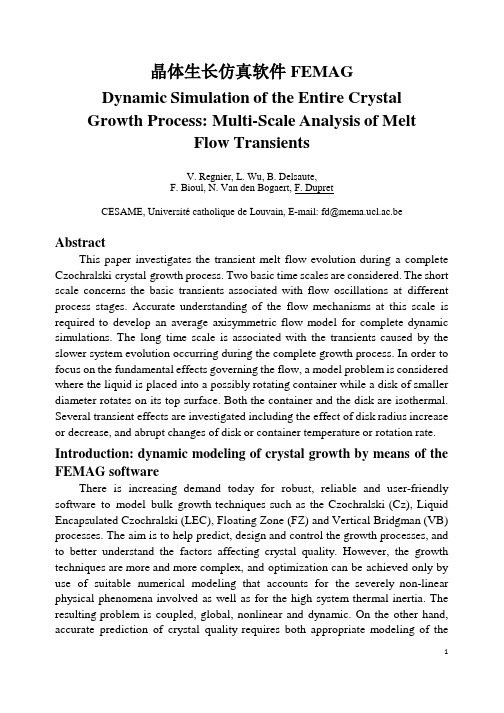利用晶体生长软件FEMAG对蓝宝石晶体生长的仿真计算方法
晶体生长模拟软件FEMAG之晶体生长各种方法

FEMAGSoft © 2010
VB Growth Method
VB is widely used to grow Si/Ge and compound crystals: (待续)………………
t 1800 1740 1680 1620 1560 1500 1440 1380 1320 1260 1200 1140 1080 1020 960 900 840 780 720 660 600 540 480 420 360 300
2) Part of Germanium crystal grown by CZ method 3) Sappher and lots Compound crystal grown by CZ or its variants, such as Kyropoulos, LEC etc. 4) Market share of CZ wafer in solar market slightly lower than DSS mc wafer
It is assumed that for a certain region of the thermal stresses the crystal is in a metastable state, and a certain perturbation energy is necessary to leave this metastable state. By this model, it can be understood that the crystal can bear higher stresses than the critical values determined by a tensile test. Conforming to the classical idea of dislocation generation it starts somewhere near the growth interface, where the highest stresses are located and then grows deeper into the crystal. At these points of high stress level, the dislocation process may be started due to a perturbation energy resulting from:
晶体生长建模软件FEMAG-模拟策略

Direct dynamic
– calculated crystal shape – precribed heater power history – effect of pull rate and solid-liquid interface deformation on the solidification heat
• To resort to appropriate and up-to-date numerical simulation techniques to couple and solve these models
→ quasi-steady and dynamic models
FEMAGSoft © 2013
Inverse dynamic simulation (imposed crystal shape, calculated heater power): power oscillations resulting from inverse modeling, and smoothed power
FEMAGSoft © 2013
Stream function
psi 7.4E-05 7.1E-05 6.8E-05 6.5E-05 6.2E-05 5.8E-05 5.5E-05 5.2E-05 4.9E-05 4.6E-05 4.3E-05 4.0E-05 3.6E-05 3.3E-05 3.0E-05 2.7E-05 2.4E-05 2.1E-05 1.7E-05 1.4E-05 1.1E-05 8.0E-06 4.8E-06 1.7E-06 -1.5E-06 -4.7E-06
Quasi-steady
– thermal equilibrium – adapted heater power Inverse dynamic to get the prescribed – adapted heater power Quasi-dynamic crystal diameter to grow the prescribed frozen geometry – –heat source on the (except the crystal shape solid-liquid interface) solidification front in – effect of pull rate and to thepower pull to getsolid-liquid interface –proportion adapted heater rate the prescribed crystal diameter deformation on the – effect of pull rate and solid-solidification heat liquid interface deformation on the solidification heat
晶体生长计算软件FEMAG系列之晶体生长方法介绍

可扩展性
软件具有开放性和可扩展性, 用户可以根据需要添加新的材 料属性和边界条件。
图形界面
提供友好的图形界面,方便用 户进行模型建立、参数设置和 结果分析。
软件应用领域
半导体晶体生长
用于研究半导体晶体生长过程中的物理和化学行 为,优化晶体质量和性能。
光学晶体生长
用于研究光学晶体的生长过程,优化晶体光学性 能和加工工艺。
增强可视化功能
为了更好地帮助用户理解和分析计算结果,FEMag软件将 增加更强大的可视化功能,如3D图形界面、实时渲染等, 使用户能够更直观地查看和操作计算结果。
拓展应用领域和范围
扩大应用领域
随着晶体生长研究的不断发展,FEMag软件的应用领域将不 断扩大。未来,FEMag软件将不仅应用于传统的晶体生长研 究,还将拓展到其他相关领域,如材料科学、化学、生物学 等。
该软件通过建立数学模型,模拟晶体生长过程中各 种因素对晶体形态、结构和性能的影响。
FEMag软件提供了丰富的材料属性和边界条件设置 ,支持多种晶体结构和生长条件。
软件特点
01
02
03
04
高效计算
采用有限元方法进行数值计算 ,能够快速求解大规模的晶体 生长问题。
精确模拟
能够模拟晶体生长过程中的温 度场、浓度场、应力场等物理 场,以及化学反应过程。
专业和深入。
与实验结果的比较
FEMag与实验的一致性
FEMag软件在模拟晶体生长方面取得了与实验结果高度一致的结果。通过对比实验和模拟数据,可以验证 FEMag软件的准确性和可靠性,进一步推动其在晶体生长研究中的应用。
实验验证的局限性
尽管FEMag软件与实验结果具有较好的一致性,但实验验证仍然存在局限性。实验条件和参数的微小变化可能 会对结果产生显著影响,而模拟结果可能无法完全反映这些细微差异。因此,将实验和模拟结果相结合,进行综 合分析是更为可靠的方法。
FEMAG晶体生长专业模拟软件-模拟策略

-建模策略
Franç ois Dupret1,2, Roman Rolinsky2, Brieuc Delsaute2, Rajesh Ramaya2, Nathalie Van den Bogaert2
1
Universitécatholique de Louvain, Louvain-la-Neuve, Belgium FEMAGSoft S.A. company, Louvain-la-Neuve, Belgium
• d) Geometrical modeling: to accurately handle strongly deforming bodies and interface and well-capture all the boundary layers
• e) Solution technique: coupled Newton-Raphson iterations by use of a highly effective linear solver
FEMAGSoft © 2013
1. Numerical strategy (cont’d)
Inverse QS and TD simulation of the Global temperature growth of a 300 field mm silicon crystal
t 1800 1740 1680 1620 1560 1500 1440 1380 1320 1260 1200 1140 1080 1020 960 900 840 780 720 660 600 540 480 420 360 300
Quasi-steady
– thermal equilibrium – adapted heater power Inverse dynamic to get the prescribed – adapted heater power Quasi-dynamic crystal diameter to grow the prescribed frozen geometry – –heat source on the (except the crystal shape solid-liquid interface) solidification front in – effect of pull rate and to thepower pull to getsolid-liquid interface –proportion adapted heater rate the prescribed crystal diameter deformation on the – effect of pull rate and solid-solidification heat liquid interface deformation on the solidification heat
利用晶体生长计算软件FEMAG进行晶体生长计算仿真的结果图 ppt课件

利用晶体生长计算软件FEMAG进行晶 体生长计算仿真的结果图
• FEMAG软件是世界上第一款商业的材料晶体生长数值模拟软件,由比利时 新鲁汶大学教授Dr. François Dupret于20世纪80年代中期领导开发。
• Dr. François Dupret是第二届晶体生长模型国际研讨会主席、EUROTHERM相 变热力学研讨会联合主席、机械工程学位委员会主席,曾担任国际晶体生 长(Journal of Crystal Growth)期刊主编。
• FEMAG软件拥有国际上最先进、最高效、最全面的晶体生长工艺模拟技术 和多物理场耦合仿真功能,可模拟的晶体生长工艺包括提拉法(柴氏法,Cz 法)、泡生法(Ky法)、区熔法(FZ法)、坩埚下降法(垂直布里兹曼法, VB法)、物理气相传输法(PVT法)等,广泛应用于集成电路、太阳能光伏 、半导体、蓝宝石等领域。ON Semiconductor(安森美半导体)、美国 Kayex、Siltronic(世创电子材料)、AXT(美国晶体技术集团)、韩国 Nexolon、LG、韩国汉阳大学、Norut(挪威北方研究所)、日本SUMCO集团 、Gritek(有研新材料)、天津环欧半导体材料、中环股份、北京有色金属 研究总院、清华大学等企业和科研机构,均是FEMAG软件的用户。
FEMAG定向凝固模拟软件用于设计新的热场,并研发新的 方法以满足新的商业需求点,比如: ✓晶体微结构 ✓优化 ✓扩大生产规模
利用晶体生长计算软件FEMAG进行晶 体生长计算仿真的结果图
利用晶体生长计算软件FEMAG进行晶体生长计 算仿真的结果图
利用晶体生长计算软件FEMAG进行晶 体生长计算仿真的结果图
利用晶体生长计算软件FEMAG进行 晶体生长计算仿真的结果图
利用晶体生长软件FEMAG对蓝宝石晶体生长的仿真计算方法

Content
➢ General introduction ➢ Sapphire Growth
Page ▪ 2
CONFIDENTIAL
Introduction
For more than 25 years, FEMAGSoft develops simulation software dedicated to the research and development of optimal crystal growth processes. 1984 First research on Germanium growth in University of Louvain.
Specifications: - Temperature in the sapphire and in all furnace components by solving the
global heat transfer in the furnace (radiation, conduction , convection). - Flow velocity in the sapphire liquid phase. - Crystallization front shape - Ohmic and Induction Heating - Advanced radiation heat transfer in the sapphire - Gas convection - Anisotropic thermal stresses in the crystal
Page ▪ 11
CONFIDENTIAL
Global simulations
No simplification of the process conditions
晶体生长计算软件FEMAG系列之晶体生长方法介绍 ppt课件

16
FEMAGSoft © 2010
定向凝固法(DSS)
在过去几年半导体晶体生长制造商都因采用直拉
法/垂直梯度凝晶体固生长法计(算软件CFZE/MVAGG系F列)之 而获益
晶体生长方法介绍
17
FEMAGSoft © 2010
定向凝固法(DSS)
定向凝固法工艺的主要问题:
增加产出 晶粒尺寸的控制和增大 掺杂/杂质( C/N )分布 位错
晶体生长计算软件FEMAG系列之 晶体生长方法介绍
22
FEMAGSoft © 2010
晶体生长计算软件FEMAG系列之晶 体生长方法介绍
1
晶体生长计算软件FEMAG 之
晶体生长方法介绍
晶体生长计算软件FEMAG系列之
2
晶体生长方法介绍
精品资料
• 你怎么称呼老师? • 如果老师最后没有总结一节课的重点的难点,你
是否会认为老师的教学方法需要改进? • 你所经历的课堂,是讲座式还是讨论式? • 教师的教鞭 • “不怕太阳晒,也不怕那风雨狂,只怕先生骂我
6
FEMAGSoft © 2010
ห้องสมุดไป่ตู้
String Ribbon法 (Evergreen Solar Inc.专利设计)
硅晶体生长方法
导模法(EFG)
晶体生长计算软件FEMAG系列之 晶体生长方法介绍
7
FEMAGSoft © 2010
热场设计的重要性
晶体生长的首要问题是设计适合的热场和 相应的操作条件,这不仅决定了晶体的主 要特性,对于每个集成电路晶片制造商而 言,也是最主要的核心技术所在。
FEMAGSoft © 2010
定向凝固法的热点问题
晶体生长计算软件FEMAG系列之 晶体生长方法介绍
利用晶体生长软件FEMAG对蓝宝石晶体生长的仿真计算方法ppt课件

RADIATION
CONVECTION CONDUCTION
MESH
GEOMETRY
…
FEMAG3 NEW 2011 •Very accurate : Finite Element and Spectral methods •Very efficient : 3D simulations in less 1 day •Very flexible : Very fast development of new demand
Specifications: - Temperature in the sapphire and in all furnace components by solving the
global heat transfer in the furnace (radiation, conduction , convection). - Flow velocity in the sapphire liquid phase. - Crystallization front shape - Ohmic and Induction Heating - Advanced radiation heat transfer in the sapphire - Gas convection - Anisotropic thermal stresses in the crystal
Page 11
CONFIDENTIAL
Global simulations
No simplification of the process conditions
Page 12
HEM Furnace for Sapphire
Czochralski Furnace for Silicon
FEMAG晶体生长建模软件-DS法(定向凝固法)模拟

DS process simulation (cont’d)
y Y Z = X + iY
z = x + iy
x
X
Real square cross-section
Transformed circular cross-section
FEMAGSoft © 2013
DS process simulation (cont’d)
This results in a system whose size is that of the 2D system multiplied by the number of Fourier modes considered and hence in a dramatic system size reduction.
3D FEM-spectral calculations
FEMAGSoft © 2013
FEMAGSoft © 2013
DS process simulation (cont’d)
Time-dependent simulation of DS process
Filling of a 20 cm side square crucible (“Minicaster” furnace)
Evolution of the temperature, velocity, oxygen and carbon concentration fields.
FEMAGSoft © 2013
DS process simulation (cont’d)
Direct solidification of multi-crystalline silicon with a square crucible
晶体生长仿真软件FEMAG--Dynamic Simulation of the Entire Crystal Growth Process

晶体生长仿真软件FEMAGDynamic Simulation of the Entire CrystalGrowth Process: Multi-Scale Analysis of MeltFlow TransientsV. Regnier, L. Wu, B. Delsaute,F. Bioul, N. Van den Bogaert, F. DupretCESAME, Université catholique de Louvain, E-mail: fd@mema.ucl.ac.be AbstractThis paper investigates the transient melt flow evolution during a complete Czochralski crystal growth process. Two basic time scales are considered. The short scale concerns the basic transients associated with flow oscillations at different process stages. Accurate understanding of the flow mechanisms at this scale is required to develop an average axisymmetric flow model for complete dynamic simulations. The long time scale is associated with the transients caused by the slower system evolution occurring during the complete growth process. In order to focus on the fundamental effects governing the flow, a model problem is considered where the liquid is placed into a possibly rotating container while a disk of smaller diameter rotates on its top surface. Both the container and the disk are isothermal. Several transient effects are investigated including the effect of disk radius increase or decrease, and abrupt changes of disk or container temperature or rotation rate.Introduction: dynamic modeling of crystal growth by means of the FEMAG softwareThere is increasing demand today for robust, reliable and user-friendly software to model bulk growth techniques such as the Czochralski (Cz), Liquid Encapsulated Czochralski (LEC), Floating Zone (FZ) and Vertical Bridgman (VB) processes. The aim is to help predict, design and control the growth processes, and to better understand the factors affecting crystal quality. However, the growth techniques are more and more complex, and optimization can be achieved only by use of suitable numerical modeling that accounts for the severely non-linear physical phenomena involved as well as for the high system thermal inertia. The resulting problem is coupled, global, nonlinear and dynamic. On the other hand,accurate prediction of crystal quality requires both appropriate modeling of the governing physics, and highly accurate dynamic numerical methods for computing the evolution of the solid-liquid interface shape and the temperature field gradient in its vicinity.The FEMAG simulation software developed in the CESAME center of the University of Louvain is currently used by major crystal growth companies. The numerical model is both global and dynamic, and takes the effect of melt convection into account. Diffuse surface radiation is considered. Geometrical unknowns are dynamically coupled to the other unknowns, i.e. temperature field, velocity field, electrical potential, etc., leading to a complex non-linear system of equations whose solution is found by use of a decoupled scheme at every time step of the simulation. Whereas in its first generation FEMAG already performed global quasi-steady or time-dependent simulations, applications were restricted to top cone, shouldering and body growth stages.Both laminar and non-laminar flow models were considered, including or not the effect of axisymmetric magnetic fields. The objective of launching the FEMAG-2 software generation has been to provide a fully automatic simulator predicting the entire growth process while handling correctly the switches between the growth stages, together with coupling dynamic calculations with accurate melt flow prediction.A significant difficulty lay in the important evolution of the system geometry during a complete growth process. Indeed, the solidified region is very small during seeding and subsequently becomes larger and larger, while the volume of the molten region decreases continually and can take a complex shape during tail-end stage. The solution adopted combines several approaches based on a representation of the furnace by means of deforming unstructured meshes together with automatic mesh generation. New geometrical methods were designed to allow easy calculation of the different system free surfaces (solidification front, melt/gas interface including crystal/melt and crucible/melt menisci, and crystal/gas surface). These methods allow performing easy time-dependent simulations even for stages of the process where important geometrical changes occur.Another important difficulty to address in FEMAG-2 development was related to the complexity of dynamic melt flow modeling. Several problems must be solved to accurately couple melt flow predictions with crystal growth process simulation. First, in semi-conductor growth, the melt flow is time-dependent, 3D and weakly turbulent, whereas it can exhibit 3D azimuthal andtemporal structured oscillations. The use of an axisymmetric quasi-steady flow model is devoted to average the effect of these oscillations, and the principal issue is to determine reliable average flow models, with the corresponding boundary conditions, above the steady laminar regime. Secondly, due to high nonlinearities, the solution of non-laminar flow problems can be quite difficult while, in most cases, these problems exhibit the numerical stability and convergence issues of transport-dominated systems. To this end, appropriate iterative schemes and stabilization techniques were introduced into the FEMAG-2 flow module. Thirdly, in order to achieve coupling with global thermal calculations, the melt flow problem is solved in FEMAG-2 at several stages of the simulation by using a quasi- steady model, while long term thermal transients are treated by including appropriate source terms into the momentum and energy equations. Interpolation between the collected results provides the flow pattern and the velocity field at each time step of the dynamic simulation.Crystal quality can be predicted from the melt flow and temperature histories as long as the physical models are known. Therefore, solid phase simulators are currently developed in FEMAG-2 to calculate defect formation, diffusion and recombination, dislocation generation and motion, etc., on the basis of heat transfer and flow simulation results. A related objective is to develop off-line control algorithms, the ultimate goal being to provide an easy way to determine the evolution of the different process parameters (heater power, pull rate, crystal and crucible rotation rates, crucible lift, magnetic field design and intensity…) in order to optimize selected process variables characterizing crystal shape and quality. For all these reasons it is of the utmost importance to develop accurate and reliable flow models for bulk crystal growth dynamic simulation. Objectives of the paper in terms of melt flow modelling The present paper is devoted to investigating the evolution of the melt flow regime and pattern during the complete Cz crystal growth process. To this end, two basic time scales must be considered. The short time scale, which is typically of the order of tens of seconds in silicon growth, concerns the basic transients associated with flow oscillations at different stages of the growth process. Accurate understanding of the flow behaviour at this scale is required to develop the average axisymmetric flow model to be used in global dynamic simulations. The long time scale, which is typically of the order of tens of minutes in Cz silicon growth, is associated with the flow and heat transfer transients caused by the long term system evolution. In particular, the melt height is continuallydecreasing during the complete growth process. In addition, the crystal radius changes significantly during cone growth and tail-end stages, while simultaneously the heat transfer is strongly affected by the heater power modifications required to obtain a crystal of the prescribed shape – it should be recalled that heater power is slowly decreased during conical growth in order to let crystal radius increase, while it experiences a quick peak during shouldering in order to stop conical growth, and it is progressively increased during tail-end stage in order to let crystal radius decrease to terminate the growth process.As the aim is here to provide better understanding of the crystal growth melt flow transients at these two time scales, a model problem is considered where the liquid is placed into a possibly rotating cylindrical container while a rotating disk of smaller diameter is placed at the top surface of the liquid. The container and the disk are at uniform, but possibly different, temperatures in order to generate buoyancy forces from radial temperature gradient effect. The advantage of this approach is to allow focusing on the fundamental effects governing the flow by reducing the number of system parameters –the latter being the height of the liquid domain, the container and disk diameters and temperatures, and some material properties of the liquid. Additional parameters can be introduced to characterize the imposed magnetic field if any, but any other effect such as radiation transfer, which is not directly affecting the flow, is removed from the model in order to focus on flow issues only. For validation purpose, this system has been the object of isothermal and non-isothermal experimental investigations by means of a simple apparatus.In order to capture the particular effects related to the flow behaviour at the short time scale (including the detail of its oscillations in a periodic, quasi-periodic or chaotic regime), a particular simulation technique has been developed where the long term effects are frozen while a laminar flow model is used. Very high mesh and time step refinements are required and therefore short time scale simulations, whose understanding represent a first objective of the paper, are limited to rather small periods of time.On the other hand, long time scale simulations can only be performed provided an appropriate axisymmetric average flow model is introduced. This non-laminar model is developed by fitting the simulations to short time scale results. The second objective of the paper is to investigate by use of this non-laminar model the importance of the long term flow transients resulting from process parameter changes, such as increase or decrease of disk radius, abrupt change of temperature or rotation rate of the disk or the container, etc. To this end,several examples will be completely analyzed and presented at the conference. ReferencesF. Dupret, P. Nicodème, Y. Ryckmans, P. Wouters, M.J. Crochet, Int. J. Heat Mass Transfer, 33 (1990), 1849.F. Dupret & N. Van den Bogaert, in Handbook of Crystal Growth, Vol. 2B, Ch. 15, Elsevier, Neth. (1994), 875. R. Assaker, N. Van den Bogaert, F. Dupret, Magnetohydrodynamics, 31 (1995), 254.N. Van den Bogaert & F. Dupret, J. Crystal Growth, 166 (1996), 446; 171 (1997), 65; 171 (1997), 77. R. Assaker, N. Van den Bogaert, F. Dupret, J. Crystal Growth, 180 (1997), 450.F. Dupret, N. Van den Bogaert, R. Assaker, V. Regnier, in Proc. 8th Int. Symp. on Si Mat. Sc. and Tech., 1998ECS meeting, Proc. Vol. 98-1 of the Electrochem. Soc., Pennington, NJ (1998), 396.T. Sinno, E. Dornberger, R.A. Brown, W. von Ammon, F. Dupret, Materials Science and Engineering: R Reports, 28 (2000), 149.。
FEMAG晶体生长模拟软件-DS法(定向凝固法)模拟

DS process simuldent simulation of DS process
Filling of a 20 cm side square crucible (“Minicaster” furnace)
Evolution of the temperature, velocity, oxygen and carbon concentration fields.
FEMAGSoft © 2013
DS process simulation (cont’d)
y Y Z = X + iY
z = x + iy
x
X
Real square cross-section
Transformed circular cross-section
FEMAGSoft © 2013
DS process simulation (cont’d)
Comparison of 3D FEM-spectral and 3D Cartesian simulations
FEMAGSoft © 2013
DS process simulation (cont’d)
Isotherms
Same isosurfaces : - Colored : 3D FEM-Spectral - Gray : 3D Cartesian
FEMAGSoft © 2013
DS process simulation (cont’d)
Direct solidification of multi-crystalline silicon with a square crucible
Hypothesis: square symmetry of all averaged fields Objective: global, quasi-steady or time-dependent calculations at a reasonable cost Method: 1. Mapping of the square cross-section onto a circle 2. Use of a particular expansion technique for all fields (velocity, pressure, temperature) in the transformed domain
晶体生长计算软件FEMAG浮区法生长晶体方法

FEMAGSoft © 2011
2. A global simulation tool (cont’d)
Induction Heating in FZ semi-conductor growth
Conduct or
d B
Dissipated power:
Force density:
Alternating magnetic field effects : 1) Heat flux
1. Introduction 2. Global simulation tool
3. Simulation examples
4. Discussion
FEMAGSoft © 2011
2. A global simulation tool
Typical FEMAG-FZ global unstructured mesh for heat transfer and induction heating
FEMAGSoft © 2011
2. A global simulation tool (cont’d)
Prediction of Crystal Defects
FEMAGSoft © 2011
2. A global simulation tool (cont’d)
Quasi-steady simulation of the growth of a 100 mm silicon crystal
Growth of a 100 mm silicon crystal
(1mm/min pull rate) Predicted defect delta -(CI-CV) distribution by means of a quasi-steady simulation
- 1、下载文档前请自行甄别文档内容的完整性,平台不提供额外的编辑、内容补充、找答案等附加服务。
- 2、"仅部分预览"的文档,不可在线预览部分如存在完整性等问题,可反馈申请退款(可完整预览的文档不适用该条件!)。
- 3、如文档侵犯您的权益,请联系客服反馈,我们会尽快为您处理(人工客服工作时间:9:00-18:30)。
Development of defect-free silicon wafer production. Today, more than 35 patents are referencing FEMAG Software 2003 FEMAGSoft S.A., spin-off from University of Louvain. 2006 Collaboratrion with major Solar companies. Development of low-cost and low-oxygen content processes. 2009 Large investment for a new software framework 2010 Release of Software application for Sapphire ingot production.
Result using coarse mesh
Result using BLM mesh
Page ▪ 25
Velocity field
FEMAGSoft © 2012
FEMAG-HEM
FEMAG-HEM Software to simulate Sapphire Growth by Heat Exchange Method
Stream function
Page ▪ 22
FEMAGSoft © 2012
Melt meshes
BLM mesh is very important to simulate the interface
Coarse mesh
Page ▪ 23
BLM (boundary layer mesh)
FEMAGSoft © 2012
Sapphire Growth by CZ and kyropoulos
Page ▪ 7
CONFIDENTIAL
Sapphire growth by HEM
Page ▪ 8
CONFIDENTIAL
What are FEMAG software?
▪ Process-dedicated simulation tools, adapted to your own processes and able to solve your problems.
利用晶体生长软件FEMAG 对蓝宝石晶体生长仿真模拟方法
Page ▪ 1
FEMAGSoft S.A., Belgium
A SPIN-OFF company from
Universite catholique de Louvain Belgium
Professor F. Dupret
CONFIDENTIAL
Specifications: - Temperature in the sapphire and in all furnace components by solving the
global heat transfer in the furnace (radiation, conduction , convection). - Flow velocity in the sapphire liquid phase. - Crystallization front shape - Ohmic and Induction Heating - Advanced radiation heat transfer in the sapphire - Gas convection - Anisotropic thermal stresses in the crystal
Content
➢ General introduction ➢ Sapphire Growth
Page ▪ 2
CONFIDENTIAL
Introduction
For more than 25 years, FEMAGSoft develops simulation software dedicated to the research and development of optimal crystal growth processes. 1984 First research on Germanium growth in University of Louvain.
CZ process with Induction Heating system
Page ▪ 20
Temperature in the crystal and in the melt
CONFIDENTIAL
FEMAG-CZ/OX
The interface shape and position is a result of the simulation
▪ Time Dependent
Page ▪ 9
CONFIDENTIAL
Process-dedicated tools
▪ FEMAG-CZ : Czochralski ▪ FEMAG-FZ : Floating Zone ▪ FEMAG-VB : Vertical Bridgman ▪ FEMAG-CZ/OX : Czochralski for Sapphire ▪ FEMAG-KY : Kyropoulos ▪ FEMAG-DS : Directional Solidification ▪ FEMAG-HEM : Heat Exchange Method
CZ process with Induction Heating system
Page ▪ 21
Melt velocity amplitude
CONFIDENTIAL
FEMAG-CZ/OX / CZ and KYROPOULOS process
Temperature field in the melt
▪ Global ▪ All the furnace components are considered. ▪ All the heat transfer mode are considered (radiation transfer, heat conduction, melt and gas convection) ▪ Induction and ohmic heating
Local temperature field
BLM mesh enables a better prediction of the crystalisation interface
Page ▪R24esult using coarse mesh
Result using BLM mesh FEMAGSoft © 2012
Specifications: - Temperature in the sapphire and in all furnace components by solving the
global heat transfer in the furnace (radiation, conduction , convection). - Flow velocity in the sapphire liquid phase. - Crystallization front shape - Advanced radiation heat transfer in the sapphire - Gas convection - Anisotropic thermal stresses in the crystal
the resulting crystal quality.
Page ▪ 16
CONFIDENTIAL
Sapphire Simulation Objective
CZOCHRALSKI
KYROPULOS
Page ▪ 17
CONFIDENTIAL
HEM
FEMAG-CZ/OX
FEMAG-CZ/OX Software to simulate Sapphire Growth by CZ and Kyropoulos
Page ▪ 18
CONFIDENTIAL
FEMAG-CZ/OX
Induction Heating system
CZ process with Induction Heating system
Page ▪ 19
Temperature in the Hot Zone
CONFIDENTIAL
FEMAG-CZ/OX
Page ▪ 15
CONFIDENTIAL
Sapphire Simulation Objective
Our goal is to provide accurate simulation tool, able to take all the process features into account and to optimize the growth process in terms of
Page ▪ 13
CONFIDENTIAL
Sapphire Crystal Growth Simulation
Page ▪ 14
CONFIDENTIAL
Sapphire Simulation Objective
➢ The market of Sapphire is experiencing a very fast growth rate and become very competitive ➢Many companies invest in simulation software in order to reinforce their positions ➢ HEM, Czochralski and Kyropoulos process require optimization and a good understanding ➢ Strong need for efficient numerical tools. ➢ Radiation effects in the participating crystal and melt is a complex problem.
